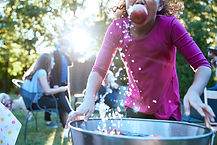Perceptual Development and the Five Senses

From the moment a baby lifts their head or takes their first steps, physical development is in motion—and it’s about so much more than just movement. For infants and toddlers, developing motor skills, learning to balance, grasp, crawl, or walk, are all deeply connected to how they think, feel, and relate to the world (Walker et al., 2020). For a child the world is a brand-new place full of sounds, colours, textures, smells, and tastes. Perceptual development—how children use their five senses to explore and make sense of their surroundings—is a key part of their growth. These early sensory experiences are essential for learning, building relationships, and developing a sense of wellbeing (Sheridan et al., 2021).
The Early Years Learning Framework (AGDE, 2022) reminds us that well-being and learning go hand in hand. When babies and toddlers are supported in their physical growth through trusting relationships and thoughtful environments, they thrive—not just physically, but in every way.
Teaching competencies and skills required
What Teachers Need to Know and Do
Supporting young children’s physical development and well-being isn’t about ticking off milestones. It’s about knowing what to look for, how to respond, and how to create spaces where movement and comfort naturally happen. Here's what effective early childhood educators bring to the table:
1. Understanding How Children Develop
Educators know what typical development looks like—but also that no two children grow in exactly the same way. They notice the small things: how a baby reaches for a toy, or how a toddler steadies themselves before a jump (Blaise et al., 2019).
2. Building Trusting Relationships
Babies and toddlers learn best when they feel safe and secure. Educators offer that emotional anchor through consistent, responsive care—picking up on cues, being present, and supporting each child with warmth and respect, Being able to read a child’s cues—like if a baby is overstimulated by noise or drawn to colourful objects—is crucial. Teachers who tune in can better support each child’s unique sensory needs (Kearns, 2020).
3. Creating Safe, Engaging Environments
The right space makes all the difference. Whether it’s a patch of grass, a cosy corner, or a set of climbing cushions, educators carefully set up environments that invite movement, curiosity, and challenge (Elliott, 2020).
4. Observing and Planning with Purpose
Observations aren't just notes—they're insights. By watching closely and reflecting on what they see, educators can plan meaningful experiences that meet each child right where they are (Nolan & Raban, 2015).
5. Describing and Naming
Talking about what children see, hear, and feel helps connect sensory experiences to language. Saying things like “That water feels cold!” or “You’re hearing the shaker—shake, shake!” promotes both vocabulary and connection (Fellowes & Oakley, 2023)


Curriculum provision and learning opportunities
Art
Experience: Scented Finger Painting on Vertical Surfaces
-
Senses Engaged: Touch, smell, sight
-
Physical Development: Strengthens shoulder, arm, and wrist muscles (gross to fine motor control)
-
Description: Children paint with scented natural colours (e.g. vanilla, mint, lemon) on upright easels or walls.
-
Why It Matters: Encourages sensory integration, upright posture, core stability, and creative expression.(Davis & Elliott, 2022)
Drama and Puppetry
Experience: Puppet Chase and Catch
-
Senses Engaged: Sight, hearing, touch
-
Physical Development: Builds coordination, agility, and visual tracking
-
Description: Educators use soft puppets to engage toddlers in simple movement games—puppets hide, dance, and "chase" the child.
-
Why It Matters: Combines social-emotional learning with movement control and responsive play.(Arthur et al., 2020)


Movement and Music
Experience: Music Mats and Movement Paths
-
Senses Engaged: Hearing, proprioception, balance
-
Physical Development: Enhances balance, coordination, and gross motor planning
-
Description: Children move across textured mats (bumpy, soft, squishy) to musical cues—stopping, jumping, crawling, or dancing.
-
Why It Matters: Promotes rhythmic movement, spatial orientation, and full-body sensory input.(Murray et al., 2015)


Language and Literacy
Experience: Sensory Storytime with Movement Cues
-
Senses Engaged: Hearing, sight, touch
-
Physical Development: Encourages fine motor gestures and whole-body movement
-
Description: Educators read books aloud using props and actions (e.g. "stretch up," "crawl like the bear," "touch the fuzzy page").
-
Why It Matters: Links literacy with physical participation, boosting comprehension and sensory-motor awareness.(Davis & Elliott, 2022)
Science
Experience: Water Play with Pouring and Scooping Tools
-
Senses Engaged: Touch, sight, hearing
-
Physical Development: Develops hand strength, grip control, and bilateral coordination
-
Description: Infants and toddlers explore pouring, splashing, and transferring water using various containers.
-
Why It Matters: Encourages prediction, exploration, and the development of motor sequences.(Bodrova & Leong, 2015)
Technologies
Experience: Push, Press, and Pull Discovery WallSenses Engaged: Touch, hearing, sightPhysical Development: Enhances fine motor precision and wrist rotationDescription: Interactive walls with pop-up flaps, levers, knobs, and sensory textures.Why It Matters: Supports cause-effect understanding and physical engagement with tools.(Arthur et al., 2020).
Engineering
Experience: Climb and Build Zone
-
Senses Engaged: Proprioception, touch, balance
-
Physical Development: Builds core strength, climbing skills, and coordination
-
Description: Children use soft blocks, ramps, and crates to create and navigate simple structures.
-
Why It Matters: Develops early engineering thinking and physical confidence through trial, error, and risk-taking.(DESE, 2022)



learning opportunities for infants and toddler

0–12 Months: “Soft Space Crawl and Feel”
Learning Focus:
-
Physical Development: Crawling, reaching, balance, core strength
-
Senses Engaged: Touch, sight, hearing
Experience Description:
A safe, low-to-the-ground sensory path is set up using textured mats, soft toys, mirrors, and gentle crinkly fabric. Infants are encouraged to move freely—rolling, reaching, or crawling—toward items that attract their attention.
How it Supports Development:
-
Promotes gross motor development by encouraging movement and exploration
-
Builds tactile discrimination through exposure to varied textures
-
Mirrors and toys foster visual engagement and social interest
-
Soft sound elements (e.g., gentle rattles) support auditory tracking

12–24 Months: “Sound and Movement Obstacle Trail”
Learning Focus:
-
Physical Development: Walking, balancing, stepping, spatial awareness
-
Senses Engaged: Hearing, proprioception, balance, touch
Experience Description:
A playful obstacle trail is created with items that respond to movement—such as stepping bells, soft textured tunnels, and rubber mats that squeak or crunch when walked on. Toddlers are invited to move through the course at their own pace.
How it Supports Development:
-
Enhances gross motor skills, especially walking, balancing, and coordination
-
Encourages auditory feedback through cause-effect sound play
-
Strengthens core and leg muscles while navigating uneven or soft surfaces
-
Supports body awareness and sensory confidence


2–3 Years: “Nature Kitchen Senses Lab”
Learning Focus:
-
Physical Development: Fine motor skills, tool use, bilateral coordination
-
Senses Engaged: Smell, taste, touch, sight
Experience Description:
Children explore a “Nature Kitchen” with real tools and natural items—crushed herbs, flower petals, citrus, grains, and water. They mix, pour, stir, and smell using safe bowls, scoops, and spoons. The experience encourages sensory cooking, pretend play, and physical skill building.
How it Supports Development:
-
Refines fine motor control and grasp strength through stirring, squeezing, and pouring
-
Boosts olfactory and tactile exploration with safe, fragrant materials
-
Encourages imaginative thinking and social collaboration
-
Builds hand-eye coordination and focus
youtube video links

REFERENCES
Australian Government Department of Education. (2022). Belonging, being and becoming: The Early Years Learning Framework for Australia (V2.0). https://www.education.gov.au/early-years-learning-framework
Blaise, M., Affrica, T., & Edwards, S. (2019). The early years learning framework in practice (2nd ed.). Pademelon Press.
Elliott, S. (2020). Outdoor learning environments: Spaces for exploration, discovery and risk-taking in the early years (2nd ed.). Pademelon Press.
Nolan, A., & Raban, B. (2015). Theories into practice: Understanding and rethinking our work with young children. Teaching Solutions.
Sims, M., & Hutchins, T. (2011). Program planning for infants and toddlers: In search of relationships. Pademelon Press.
Walker, S., Berthelsen, D., & Nicholls, D. (2020). Developmental psychology and early childhood education: A guide for students and practitioners (2nd ed.). Cambridge University Press.
Arthur, L., Beecher, B., Death, E., Dockett, S., & Farmer, S. (2020). Programming and planning in early childhood settings (8th ed.). Cengage Learning Australia.
Bodrova, E., & Leong, D. J. (2015). Tools of the mind: The Vygotskian approach to early childhood education (2nd ed.). Pearson.
Davis, J., & Elliott, S. (2022). Research in early childhood education for sustainability: International perspectives and provocations. Routledge.
Department of Education, Skills and Employment (DESE). (2022). Belonging, Being & Becoming: The Early Years Learning Framework for Australia (V2.0). Australian Government.
https://www.education.gov.au
Murray, L., McFarland, L., & Sanders, S. (2015). Young children’s physical development: Supporting wellbeing, movement, and play. Pearson Education.